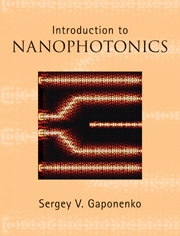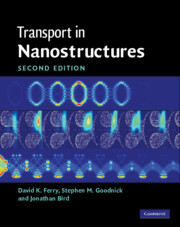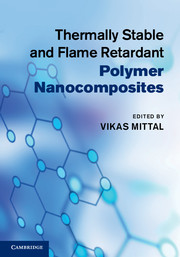Refine listing
Actions for selected content:
881 results in Ebooks in nanotechnology

Quantum Mechanics for Nanostructures
-
- Published online:
- 05 June 2012
- Print publication:
- 20 May 2010

Introduction to Nanophotonics
-
- Published online:
- 05 June 2012
- Print publication:
- 08 April 2010

Transport in Nanostructures
-
- Published online:
- 05 June 2012
- Print publication:
- 20 August 2009

Thermally Stable and Flame Retardant Polymer Nanocomposites
-
- Published online:
- 05 August 2011
- Print publication:
- 30 June 2011
8 - Flame retardant nanocomposites with polymer blends
- from Part II - Flame retardancy
-
-
- Book:
- Thermally Stable and Flame Retardant Polymer Nanocomposites
- Published online:
- 05 August 2011
- Print publication:
- 30 June 2011, pp 186-209
-
- Chapter
- Export citation
Index
-
- Book:
- Thermally Stable and Flame Retardant Polymer Nanocomposites
- Published online:
- 05 August 2011
- Print publication:
- 30 June 2011, pp 383-387
-
- Chapter
- Export citation
Contents
-
- Book:
- Thermally Stable and Flame Retardant Polymer Nanocomposites
- Published online:
- 05 August 2011
- Print publication:
- 30 June 2011, pp v-x
-
- Chapter
- Export citation
Part I - Thermal stability
-
- Book:
- Thermally Stable and Flame Retardant Polymer Nanocomposites
- Published online:
- 05 August 2011
- Print publication:
- 30 June 2011, pp 1-2
-
- Chapter
- Export citation
2 - Mechanism of thermal degradation of layered silicates modified with ammonium and other thermally stable salts
- from Part I - Thermal stability
-
-
- Book:
- Thermally Stable and Flame Retardant Polymer Nanocomposites
- Published online:
- 05 August 2011
- Print publication:
- 30 June 2011, pp 29-63
-
- Chapter
- Export citation
4 - Poly(ethylene terephthalate) nanocomposites using nanoclays modified with thermally stable surfactants
- from Part I - Thermal stability
-
-
- Book:
- Thermally Stable and Flame Retardant Polymer Nanocomposites
- Published online:
- 05 August 2011
- Print publication:
- 30 June 2011, pp 100-120
-
- Chapter
- Export citation
7 - Introduction to flame retardancy of polymer–clay nanocomposites
- from Part II - Flame retardancy
-
-
- Book:
- Thermally Stable and Flame Retardant Polymer Nanocomposites
- Published online:
- 05 August 2011
- Print publication:
- 30 June 2011, pp 161-185
-
- Chapter
- Export citation
Frontmatter
-
- Book:
- Thermally Stable and Flame Retardant Polymer Nanocomposites
- Published online:
- 05 August 2011
- Print publication:
- 30 June 2011, pp i-iv
-
- Chapter
- Export citation
Contributors
-
- Book:
- Thermally Stable and Flame Retardant Polymer Nanocomposites
- Published online:
- 05 August 2011
- Print publication:
- 30 June 2011, pp xi-xvi
-
- Chapter
- Export citation
5 - Thermally stable polyimide/4,4′-bis(4-aminophenoxy)phenylsulfone-modified clay nanocomposites
- from Part I - Thermal stability
-
-
- Book:
- Thermally Stable and Flame Retardant Polymer Nanocomposites
- Published online:
- 05 August 2011
- Print publication:
- 30 June 2011, pp 121-142
-
- Chapter
- Export citation
Preface
-
- Book:
- Thermally Stable and Flame Retardant Polymer Nanocomposites
- Published online:
- 05 August 2011
- Print publication:
- 30 June 2011, pp xvii-xviii
-
- Chapter
- Export citation
9 - Flame retardancy of polyamide/clay nanocomposites
- from Part II - Flame retardancy
-
-
- Book:
- Thermally Stable and Flame Retardant Polymer Nanocomposites
- Published online:
- 05 August 2011
- Print publication:
- 30 June 2011, pp 210-236
-
- Chapter
- Export citation
6 - Clays modified with thermally stable ionic liquids with applications in polyolefin and polylactic acid nanocomposites
- from Part I - Thermal stability
-
-
- Book:
- Thermally Stable and Flame Retardant Polymer Nanocomposites
- Published online:
- 05 August 2011
- Print publication:
- 30 June 2011, pp 143-158
-
- Chapter
- Export citation
3 - Thermal stability of polystyrene nanocomposites from improved thermally stable organoclays
- from Part I - Thermal stability
-
-
- Book:
- Thermally Stable and Flame Retardant Polymer Nanocomposites
- Published online:
- 05 August 2011
- Print publication:
- 30 June 2011, pp 64-99
-
- Chapter
- Export citation
Part II - Flame retardancy
-
- Book:
- Thermally Stable and Flame Retardant Polymer Nanocomposites
- Published online:
- 05 August 2011
- Print publication:
- 30 June 2011, pp 159-160
-
- Chapter
- Export citation
1 - Polymer nanocomposites
- from Part I - Thermal stability
-
-
- Book:
- Thermally Stable and Flame Retardant Polymer Nanocomposites
- Published online:
- 05 August 2011
- Print publication:
- 30 June 2011, pp 3-28
-
- Chapter
- Export citation
